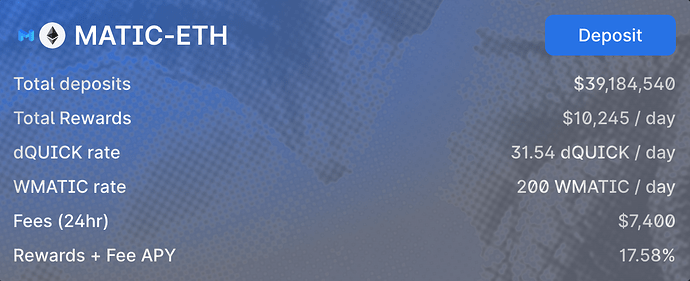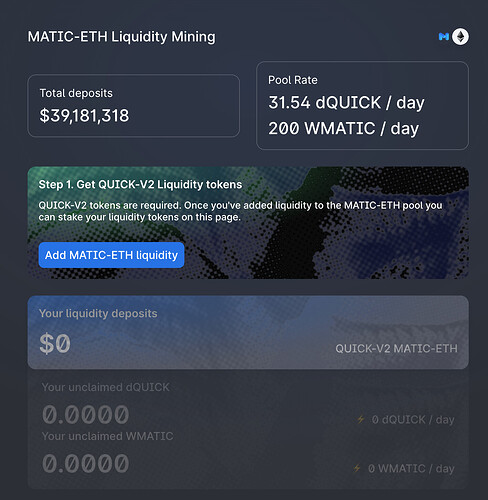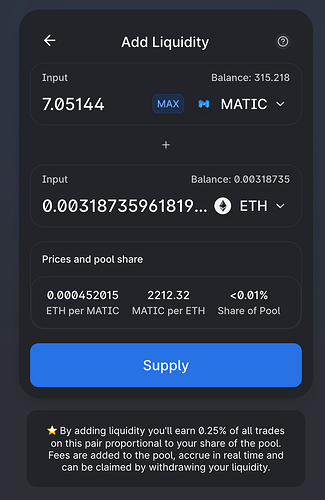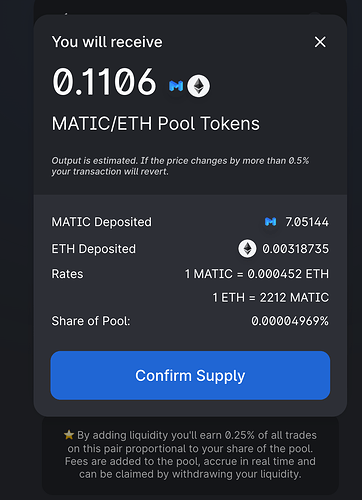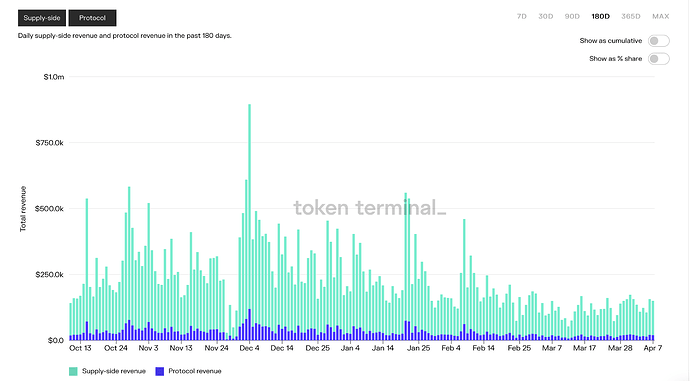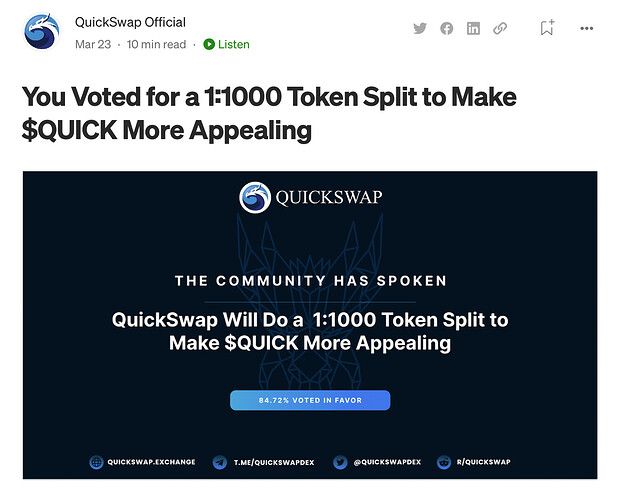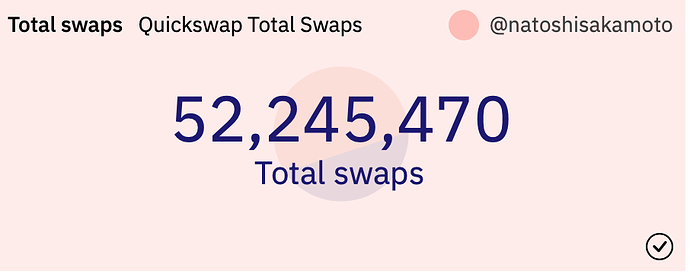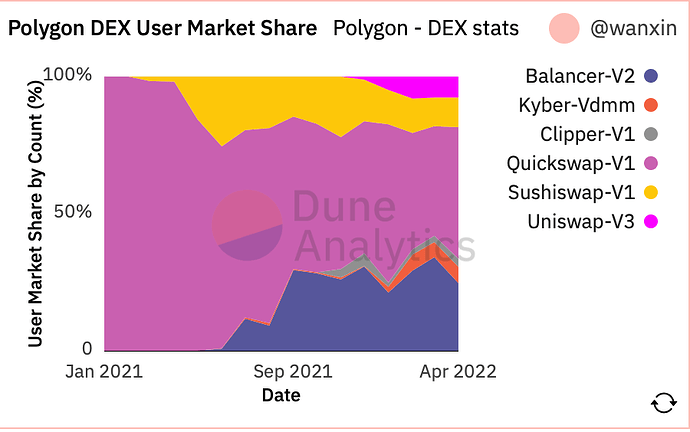If you’ve ever played around in the Polygon ecosystem, you’re probably familiar with Quickswap already.
Quickswap is the AMM that always seems to be towards the top of the list of most used dapps on Polygon. They’re a fork of Uniswap, so I’m sure a lot of you already know how to use the platform. However I wanted to go over the project today and show new people in the industry how they can earn some sweet yields on their ERC-20 tokens, considering Quickswap just launched a joint incentives program with Polygon Ecosystem DAO a couple of days ago.
According to the original forum post: “Every month two projects aiming to create a pool (or which already have a pool) on Quickswap will get an incentive in the form of QUICK rewards for liquidity providers. Moreover, the Polygon Ecosystem DAO will organize an AMA and provide for marketing communications.”
What all this means for us users is that some juicy rewards are coming, which is what inspired todays article.
What Is Quickswap
Quickswap a permissionless, open sourced decentralized exchange that runs on Polygon, providing fast and cheap transactions for users of the platform.
There are three main types of decentralized exchanges: automated market makers (AMM’s), order book exchanges, and DEX aggregators.
You can think of a DEX aggregator as like an Expedia, or any other flight aggregators. These types of exchanges aggregate token prices from all across different exchanges and give users the cheapest price.
Order book exchanges are what we’re used to seeing in the traditional financial world. These types of exchanges use order books to represent liquidity and determine prices. They require intermediary infrastructure to match orders between buyers and sellers, and look something like this:
AMM’s were initially introduced by Vitalik Buterin in 2017, then brought to life and popularized by projects like Bancor, Uniswap, and Curve.
An AMM is a smart contract that holds on chain liquidity and reserves. Users are able to trade against these reserves at prices set by the constant product formule: x * y = k, where x and y are equal amounts of a liquidity pool’s assets, and k is the total or constant amount of pool liquidity. Basically, when either token is withdrawn (purchased), an equal amount of the other is deposited (sold) to maintain the constant. Here’s an article from Paradigm Research if you’re interested in learning more about how AMM’s work.
Some advantages for AMM’s include: decentralization, security, token accessibility, non custodial, and no manipulation.
Quickswap Users
There are three main types of users on Quickswap:
- Liquidity providers (LP’s) who deposit their ERC-20 tokens into a pool for rewards.
- Traders, who swap between these ERC-20 tokens for a 0.25% trading fee. This fee goes towards the LP’s.
- Developers who integrate Quickswap into their own project or dapp.
Liquidity Providers
Becoming an LP means you’re adding your own liquidity (tokens) inside a pool. People from all around the world deposit their own tokens inside a certain pool, so that other people can swap against those tokens.
Each Quickswap pair manages a liquidity pool made up of reserves of two ERC-20’s. These pairs act as the AMM’s, standing ready to accept one token for the other.
Anyone can become an LP in Quickswap, and in return they get to earn a 0.25% fee on all trades proportional to their share of the pool. This, plus any other APY percentages or token rewards that come with depositing your LP tokens. Of course as stated on their docs: “There is a risk of losing money during large and sustained movement in the underlying asset price compared to simply holding an asset” — i.e. impermanent loss.
Here’s how you can become an LP and start earning rewards:
First you want to make sure you have your Metamask wallet, or whatever wallet you’re using (as long as it’s compatible with Quickswap of course) set to the Matic Network. Here’s a guide to get your Metamask set up wtih the Matic Networkincase you’re interested.
Once you have the Matic Network set up on your Metamask wallet, you’re going to head over to the Quickswap websiteand click on “Connect to a wallet” on the top right corner of the screen.
Then you head over to the top left of the screen and click on “LP Mining” or “Dual Mining.” Here you can see a list of the different pools you can provide liquidity to. The difference between the two being that with “Dual Mining” you’re getting yield rewards in two crypto assets, which can increase profits.
I’m under a “Dual Mining” pool, and will be using the MATIC-ETH pair as an example:
First you want to make sure you have 50% of each token in the pool. In USD value, not in token amount. So in my case here I need to make sure I have $20 each in both MATIC and ETH. Or $100 of each, or whatever amount I choose, it just has to be the same for both.
So click on deposit on whichever pool you’re interacting with, and then you’ll be greeted with something that looks like this:
Once I have both tokens, I’m going to click on “Add MATIC-ETH liquidity”:
I add both tokens, so in my case I add both MATIC & ETH — Once you enter the amount of one of the tokens you want to deposit to the pool, the other one should automatically adjust to equate to the same value as the other.
Then click on “Supply”:
You’ll see this confirmation page. Just click on “confirm supply”. Then you should be directed to sign for the transaction in your Metamask wallet.
Once you sign for the transaction and it confirms on Polygon, you’ll receive a certain amount of LP tokens, which represent the liquidity you just supplied. These can be burned at any time to retrieve your original share of tokens you deposited, along with any trading fees and token rewards you’ve made along the way.
These LP tokens by themselves are earning you trading fees from the platform (0.25%), but you can deposit these LP tokens into a pool to earn even more rewards.
Once you receive these LP tokens, you head on back to the original liquidity pool page for your certain pair. So in my case it’ll look something like this:
From here you click on “Deposit LP Tokens.” You approve, and then deposit your LP tokens to start earning whatever amount of APY or earnings were displayed for your specific pool.
Tokenomics
Currently $QUICK is trading at around $219, with a market cap of $71 million, and fully diluted market cap of around $214 million. So cheap when compared to competition! Of course this can be due to the fact that protocol revenue(revenue that goes back to token holders) isn’t too high. That’s because most of the revenue is supply side revenue, or revenue that goes back to the LP’s.
Here’s a chart showing the difference between protocol revenue and supply side revenue.
e
1:1000 Token Split
Last month, the Quickswap community voted in favor of raising the max supply of $QUICK tokens from 1 million, to 1 billion. So those who hold 1 $QUICK token before the split, will hold 1000 $QUICK after the split.
Something important to note is that Quickswap was a fair launch token. No seed sale, private sale or public sale. Literally 90% of all $QUICK tokens will be distributed to the QuickSwap community via liquidity mining rewards, which are slated to be paid out until 2025.
Token Utility
The $QUICK token has several utilities, including:
- Providing Liquidity: $QUICK can be deposited inside certain liquidity pools and earn you trading fee rewards.
- Yield Farming: You can stake your LP tokens in LP Mining or Dual Mining to earn more rewards on top of the pool’s trading fees.
- Governance: Quickswap is run by a DAO, where the more $QUICK tokens you own, the more voting power and say you have in the direction and governance of Quickswap.
- You can stake in the Dragon’s Lair to earn even more $QUICK. When you deposit here you’ll receive $dQUICK in return.
- Another option is to stake your $QUICK tokens in the Dragon’s Syrup Pools and earn yields that way.
- Participating in IDO’s: Here’s a link to an article you can check out if you’re interested in learning more about this topic.
Some Analytics
First let’s take a look at the number of Quickswap users:
As we can see, the number of users has grown exponentially since the platforms launch in late 2020. Considering Quickswap has always been the number one DEX on Polygon since the platforms launch, it only made sense for them to follow a similar growth rate during this time frame.
Now let’s take a look at the number of total swaps and LP’s on the platform:
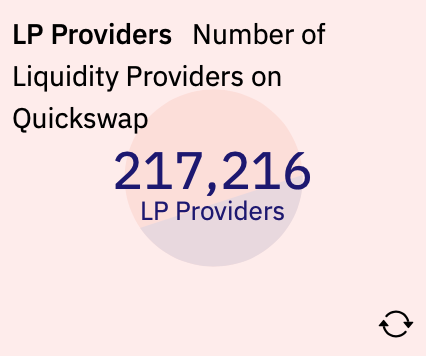
Finally, here are some Quickswap metrics shown against other Polygon DEX’s, including the recently launched Uniswap V3:
So as we can see Quickswap has remained dominant, even with the high amount of competition. Personally I do think Uniswap V3 will continue to grow more and more over time on Polygon. That being said, I think it’s safe to say that Quickswap will remain a key player within the Polygon ecosystem for the foreseeable future.
Closing Thoughts
Quickswap is the biggest AMM on Polygon — if you’ve ever played in the Polygon ecosystem, you’ve probably interacted with Quickswap already.
The platform has grow exponentially since their launch, and will continue to grow over time as more and more people join the Polygon ecosystem. Although Polygon is filled with DEX’s, including Uniswap, Quickswap will remain one of the key players within Polygon’s DeFi ecosystem.
As mentioned in the beginning of the article, Quickswap and Polygon Ecosysetm DAO have started a joint liquidity program, which means some juicy returns coming for us end users. For any farmers out there, I’d keep up with the Quickswap twitter handle, or Polygon DAO forum to stay up to date with the new pools that get added over time through this joint program.

